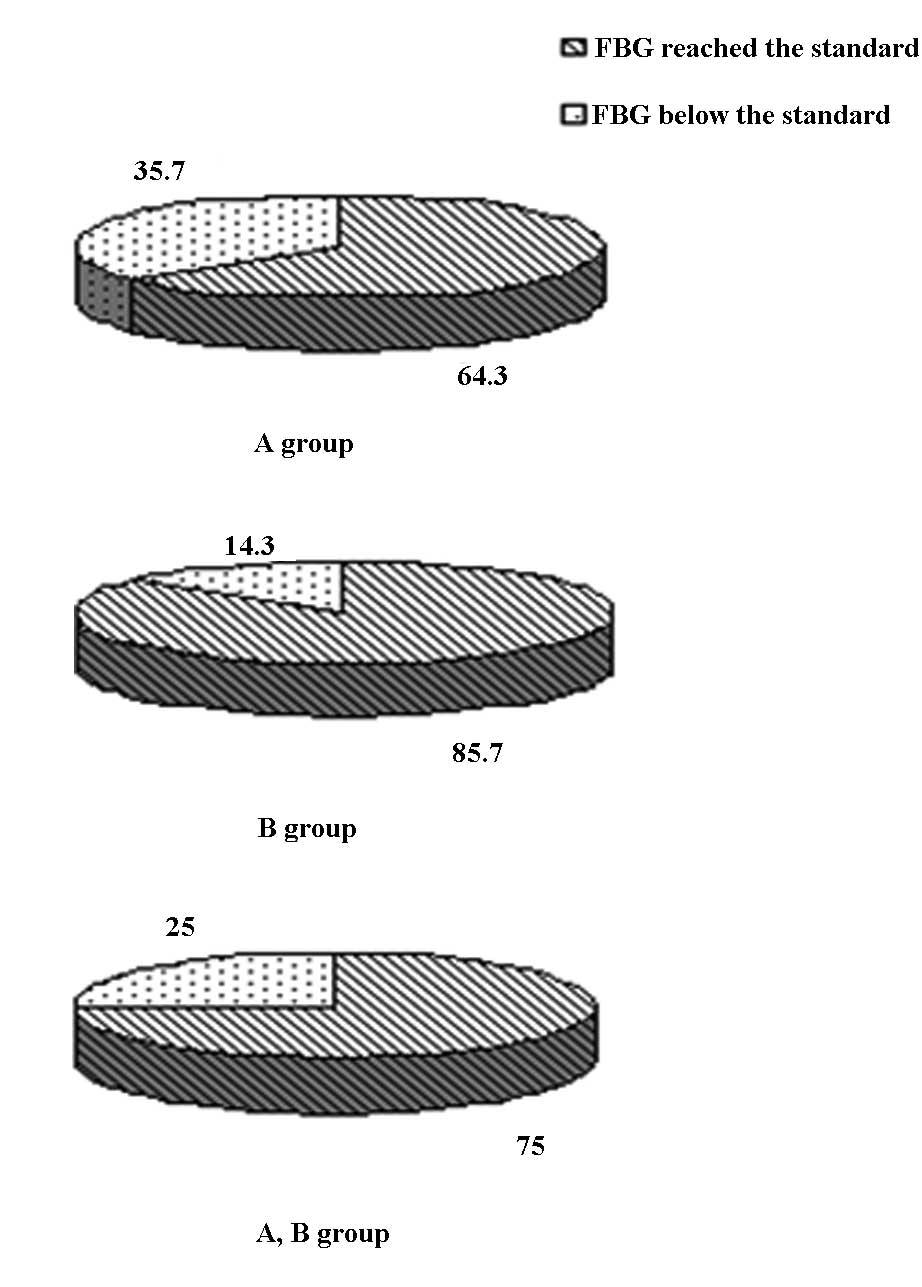|
1
|
Yang Y, Yao JJ, Du JL, et al: Primary
prevention of macroangiopathy in patients with short-duration type
2 diabetes by intensified multifactorial intervention: seven-year
follow-up of diabetes complications in Chinese. Diabetes Care.
36:978–984. 2013.
|
|
2
|
Gaede P, Lund-Andersen H, Parving HH and
Pedersen O: Effect of a multifactorial intervention on mortality in
type 2 diabetes. N Engl J Med. 358:580–591. 2008. View Article : Google Scholar : PubMed/NCBI
|
|
3
|
Holman RR, Paul SK, Bethel MA, Matthews DR
and Neil HA: 10-year follow-up of intensive glucose control in type
2 diabetes. N Engl J Med. 359:1577–1589. 2008.PubMed/NCBI
|
|
4
|
Rizvi AA and Ligthelm RJ: The use of
premixed insulin analogues in the treatment of patients with type 2
diabetes mellitus: advantages and limitations. Insulin. 2:68–79.
2007. View Article : Google Scholar
|
|
5
|
Miser WF, Arakaki R, Jiang H, Scism-Bacon
J, Anderson PW and Fahrbach JL: Randomized, open-label,
parallel-group evaluations of basal-bolus therapy versus insulin
lispro premixed therapy in patients with type 2 diabetes mellitus
failing to achieve control with starter insulin treatment and
continuing oral antihyperglycemic drugs: a noninferiority
intensification substudy of the DURABLE trial. Clin The.
32:896–908. 2010.
|
|
6
|
Levit S, Toledano Y and Wainstein J:
Improved glycaemic control with reduced hypoglycaemic episodes and
without weight gain using long-term modern premixed insulins in
type 2 diabetes. Int J Clin Pract. 65:165–171. 2011. View Article : Google Scholar
|
|
7
|
Vaag A and Lund SS: Insulin initiation in
patients with type 2 diabetes mellitus: treatment guidelines,
clinical evidence and patterns of use of basal vs premixed insulin
analogues. Eur J Endocrinol. 66:159–170. 2012. View Article : Google Scholar
|
|
8
|
Fritsche A, Larbig M, Owens D and Häring
HU; the GINGER study group. Comparison between a basal-bolus and a
premixed insulin regimen in individuals with type 2
diabetes-results of the GINGER study. Diabetes Obes Metab.
12:115–123. 2010. View Article : Google Scholar : PubMed/NCBI
|
|
9
|
Giugliano D, Maiorino MI, Bellastella G,
Chiodini P, Ceriello A and Esposito K: Efficacy of Insulin Analogs
in Achieving the Hemoglobin A1c Target of <7% in Type 2
Diabetes: Meta-analysis of randomized controlled trials. Diabetes
Care. 34:510–517. 2011.
|
|
10
|
Hammer H and Klinge A: Patients with type
2 diabetes inadequately controlled on premixed insulin: effect of
initiating insulin glargine plus oral antidiabetic agents on
glycaemic control in daily practice. Int J Clin Pract.
61:2009–2018. 2007. View Article : Google Scholar
|
|
11
|
Bu S, Guo XH, Yang WY, et al: Post-hoc
analyses of type 2 diabetes patients switch from premixed insulin
regimen to basal insulin plus oral hypoglycemic agents regimen.
Zhong Hua Yi Xue Za Zhi. 87:3115–3118. 2007.(In Chinese).
|
|
12
|
Davies M, Lavalle-González F, Storms F and
Gomis R; AT, LANTUS Study Group. Initiation of insulin glargine
therapy in type 2 diabetes subjects suboptimally controlled on oral
antidiabetic agents: results from the AT.LANTUS trial. Diabetes
Obes Metab. 10:387–399. 2008. View Article : Google Scholar
|
|
13
|
Gómez-Peralta F, Carramiñana-Barrera F,
Félix-Redondo FJ and Fraile-Gómez J; Extreme Rescue Study Group.
Glycaemic control in patients with type 2 diabetes switching from
premixed insulin to long-acting basal insulin analogue plus oral
antidiabetic drugs: an observational study. Int J Clin Pract.
66:959–968. 2012.PubMed/NCBI
|
|
14
|
Yang W, Lv X, Li Q, Jia W and Tian H: A
prospective study to optimize insulin treatment by switching to
insulin glargine in type 2 diabetic patients previously
uncontrolled on premixed insulin: the optimization study. Curr Med
Res Opin. 28:533–541. 2012. View Article : Google Scholar
|
|
15
|
Li X, Zhou ZG, Qi HY, Chen XY and Huang G:
Replacement of insulin by fasting C-peptide in modified homeostasis
model assessment to evaluate insulin resistance and islet beta cell
function. Zhong Nan Da Xue Xue Bao Yi Xue Ban. 29:419–423. 2004.(In
Chinese).
|
|
16
|
Ligthelm RJ, Gylvin T, DeLuzio T and
Raskin P: A comparison of twice-daily biphasic insulin aspart 70/30
and once-daily insulin glargine in persons with type 2 diabetes
mellitus inadequately controlled on basal insulin and oral therapy:
a randomized, open-label study. Endocr Pract. 17:41–50. 2011.
View Article : Google Scholar
|
|
17
|
Standl E, Maxeiner S, Raptis S,
Karimi-Anderesi Z and Schweitzer MA; HOE901/4009 Study Group. Good
glycemic control with flexibility in timing of basal insulin
supply: a 24-week com-parison of insulin glargine given once daily
in the morning or at bedtime in combination with morning
glimepiride. Diabetes Care. 28:419–420. 2005. View Article : Google Scholar
|
|
18
|
Janka HU, Plewe G, Riddle MC,
Kliebe-Frisch C, Schweitzer MA and Yki-Järvinen H: Comparison of
basal insulin added to oral agents versus twice-daily premixed
insulin as initial insulin therapy for type 2 diabetes. Diabetes
Care. 28:254–259. 2005. View Article : Google Scholar : PubMed/NCBI
|
|
19
|
Porcellati F, Lucidi P, Rossetti P, et al:
Differential effects of adiposity on pharmacodynamics of basal
insulins NPH, glargine, and detemir in type 2 diabetes mellitus.
Diabetes Care. 34:2521–2523. 2011. View Article : Google Scholar : PubMed/NCBI
|
|
20
|
Nathan DM, Buse JB, Davidson MB, et al:
Medical management of hyperglycemia in type 2 diabetes: a consensus
algorithm for the initiation and adjustment of therapy: a consensus
statement of the American Diabetes Association and the European
Association for the Study of Diabetes. Diabetes Care. 32:193–203.
2009. View Article : Google Scholar
|
|
21
|
Romero-Márquez RS, Díaz-Veja G and
Romero-Zepeda H: Style and quality of life in patients with type 2
diabetes. Rev Med Inst Mex Seguro Soc. 49:125–136. 2011.(In
Spanish).
|
|
22
|
Shrestha P and Ghimire L: A review about
the effect of life style modification on diabetes and quality of
life. Glob J Health Sci. 4:185–190. 2012.PubMed/NCBI
|













